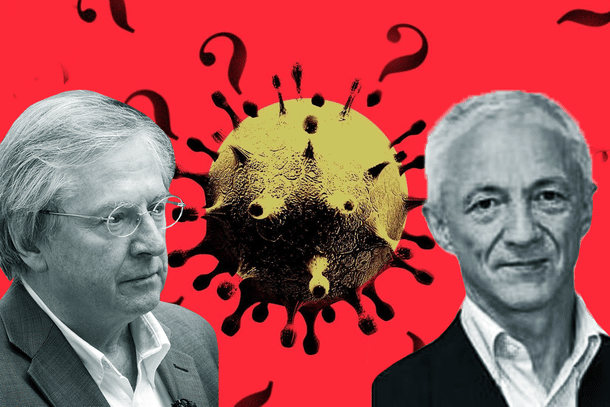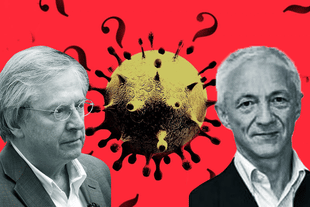News Brief
Closer Look: Two Notable Virologists Claim “Unique Fingerprints” On COVID-19 Samples Could Only Be Lab-Made
Swarajya Staff
Jun 04, 2021, 01:35 PM | Updated 01:35 PM IST
Save & read from anywhere!
Bookmark stories for easy access on any device or the Swarajya app.


In an explosive 22-page research paper accessed by the Daily Mail, two notable virologists — British professor Angus Dalgleish, best known for creating the world's first 'HIV vaccine'; and Norwegian virologist Dr Birger Sørensen, chair of pharmaceutical company Immunor who has published 31 peer-reviewed papers and holds several patents — claim to have found “unique fingerprints” on COVID-19 samples that can only be lab-made.
Sørensen had told Norwegian broadcaster NRK last year that the virus had properties which have “never been detected in nature", and that the United States has 'collaborated for many years on coronavirus research through "gain of function" studies with China.
The research paper set to be published in the scientific journal Quarterly Review of Biophysics Discovery claims that an analysis of the virus samples last year led to the discovery of "unique fingerprints" in the form of "six inserts" created through gain-of-function research at the Wuhan Institute of Virology in China.
The virologists have included two diagrams in the paper to show, respectively, six fingerprints that hint that the virus is lab-made; and the row of four amino acids with positive charge on a spike that helps the virus bind better to human cells — increasing its infectiousness.
In the abstract, the authors say:
“By 17 May 2020, we had discovered that the spike has six inserts which are unique fingerprints with five salient features indicative of purposive manipulation and we circulated an interim account in July 2020. In this paper, we publish an updated and more complete account of the virus aetiology and posit that the likelihood of it being a result of natural processes is very small.”
The virologists further say that since all the relevant biological, computer-record and direct testimony from Wuhan was destroyed or unavailable, they used active scientific logic to form and assess hypotheses.
The scientists first describe the method of “engineering” a virus for Gain of Function experiments. Then they update the biochemical analysis of the COVID-19 virus’s Mode of Action. Next, they set out the logic of their methodological choices.
Finally, the scientists add a diachronic dimension (an enquiry into how something developed and evolved through time) by “analyzing the sequence of five linked projects” which shows how, where, when, and by whom the COVID-19 spike acquired its special characteristics.
In the paper, the virologists summarise their months’ long forensic analysis into experiments done at the Wuhan lab between 2002 and 2019.
The paper includes a ‘Genbank’ table with various the coronavirus strains with the dates on which they were collected, and the dates on which they were submitted to the Genebank. Some of these show a delay of several years between collection and submission.
They duo conclude that "SARS-Coronavirus-2 has "no credible natural ancestor" and that it is "beyond reasonable doubt" that the virus was created via "laboratory manipulation."
Reportedly, the paper, the authors piece together how Chinese scientists, some of them working in concert with US-based universities, allegedly built the tools to create the coronavirus as part of the 'Gain of Function' research.
The ‘Gain of Function’ research involves tweaking naturally occurring viruses to make them more infectious, so that they can replicate in human cells in a lab, so that the scientists can better study the virus's potential effect on humans. The research can be potentially used to create biological weapons. It was temporarily outlawed in the US under the Obama administration.
Dalgleish and Sørensen claim in the paper that Chinese scientists in Wuhan took a natural coronavirus 'backbone' found in Chinese cave bats and spliced onto it a new 'spike', turning it into the deadly and highly transmissible SARS-Cov-2.
The proof?
They point to a row of four amino acids found on the SARS-Cov-2 spike. Sørensen told Daily Mail that the amino acids all have a positive charge, which cause the virus to tightly cling to the negatively charged parts of human cells, and hence the higher infectivity.
“But because, like magnets, the positively charged amino acids repel each other, it is rare to find even three in a row in naturally occurring organisms, while four in a row is extremely unlikely,” the scientist was quoted as saying.
“The laws of physics mean that you cannot have four positively charged amino acids in a row. The only way you can get this is if you artificially manufacture it,” he added.
Apart from Dalgleish and Sørensen, other scientists have also pointed to features that indicate that the virus could be lab-made.
One indication is the fact that the virus binds more strongly to human ACE2 enzymes than any other species, including bats.
Secondly, COVID-19 has a "furin cleavage site" missing in its closes bat-coronavirus relative, RaTG-13, which makes it significantly more infectious.
"There are many reasons to believe that the COVID-19 generating SARS-CoV-2 was generated in a lab. Most probably by methods of genetic engineering, I believe that this is the only way an insertion like the FURIN protease cleavage site could have been introduced directly at the right place and become effective," Israeli geneticist Ronen Shemesh was quoted as saying.
He said that it is even “more unlikely” that this insertion happened in exactly the right place of the cleavage site of the spike protein - which is where it would need to occur to make the virus more infectious.




